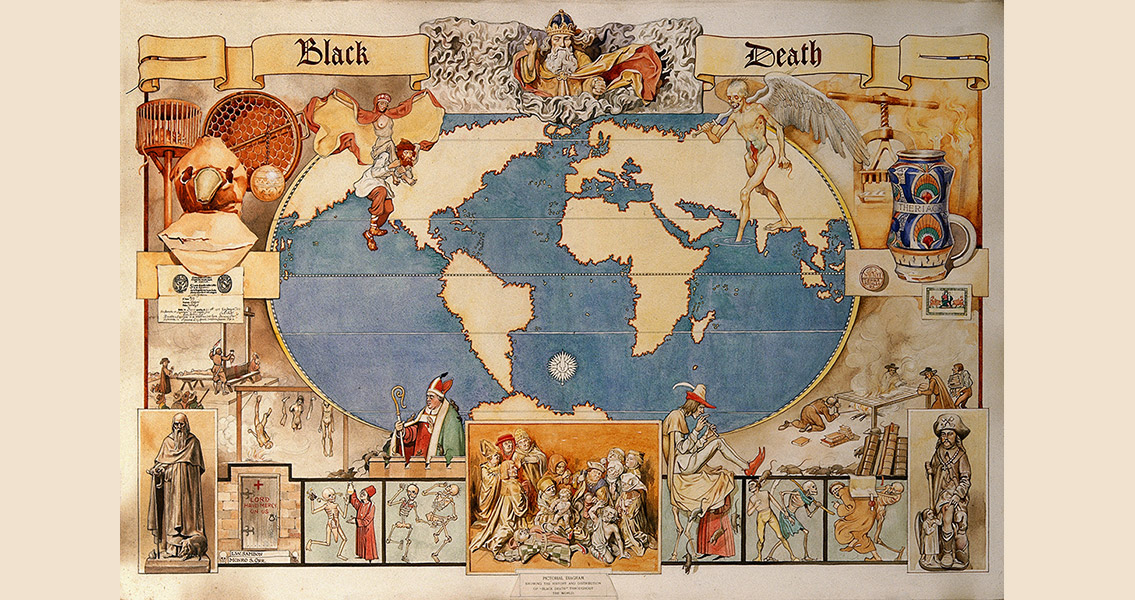<![CDATA[If you believe fourteenth century scholars from the University of Paris, the Black Death was created on 20th March, 1345, as a consequence of an astrological event. The academics attributed the outbreak of the Plague in the fourteenth century which decimated Europe to a "triple conjunction of Saturn, Jupiter and Mars in the 40th degree of Aquarius, occurring on 20th March, 1345." It's a conclusion which provides an insight into how a society with little understanding of bacteria and disease explained the onset of a massive epidemic. Arguably the worst epidemic of medieval Europe, the Black Death spanned five years, from 1347 to 1351. It was devastating, killing up to 25 million people, a third of the continent's population. Just as quickly as it came it retreated, but outbreaks would occur sporadically in Europe up until the eighteenth century. Victims suffered a painful, sudden death. Starting with flu symptoms, black buboes (swellings) would soon appear on the sufferer's groin and armpits. Livid black spots would then spread over the patient's body. The victim would usually die within three days of displaying the initial symptoms. The mortality rate was 90% - 95%. Medieval doctors, scientists and religious figures were at a loss to explain the disease, and increasingly they turned to the supernatural, the irrational and the divine. Unsurprisingly, due to the deeply religious time in which the Plague struck, the horrifying epidemic was quickly placed into a biblical framework. Sudden outbreaks of disaster of course had precedent in the Bible, in the form of the Ten Plagues brought against Egypt in the Old Testament. Religious scholars claimed that the deadly disease had been sent by God as a punishment for mankind's growing sin. Even doctors at the Medical Faculties of European Universities came to accept this religious explanation for the Black Death. It triggered a wave of piety, but also a growing fear among Christians that the Plague was caused by non-Christian elements in their societies. The antisemitism which seemed to plague Europe throughout the Medieval period bubbled to prominence again as part of another explanation for the tragedy. Jews, as has so often been the case historically, were made scapegoats for a disaster tearing through Europe. Rumours started to spread accusing Jews of causing the Plague by poisoning the water supply. In the summer of 1648, several Jews were captured in Switzerland and accused of putting poison in wells, confessions extracted through torture enough to justify the irrational fears for some. A series of horrific pogroms erupted across Europe, the stability of medieval society undone by disease and fear. Although several monarchs tried to protect the Jews in their kingdoms, the attempts proved fruitless. "Christians massacred Jews in Germany and other parts of the world where Jews lived, and many thousands were burned everywhere, indiscriminately," wrote Jean de Venette, a renowned French chronicler from the time. Although perhaps seeming outlandish now, the astrological explanation offered by the University of Paris was considered among the most scientific during the fourteenth century. Scholars in the period tied the Plague in with recent unusual environmental events, including a series of major earthquakes in Italy and what is now Germany, and unusally warm weather. They believed that miasmas - pockets of 'corrupted air', were spreading around the continent and triggering poor health. The miasma explanation is of course inaccurate, but it does reflect a certain logic which was ultimately restricted by the limited scientific knowledge of the period. Some modern scientists believe that although originating in fleas, the Plague eventually became air born. It also undoubtedly occurred most frequently in overpopulated, polluted cities. The miasma explanation suggests fourteenth century scholars also noticed these trends, even if they came up with a vastly different explanation. Similarly, some scientists have postulated that the warm, dry summers of the period encouraged the spread of rats, a possible carrier of the Plague. Again, medieval scholars were able to connect different factors in the Plague's spread, even if their explanations are now largely discredited. Planetary movements were considered as another possible cause of these miasmas. As were the earthquakes and unusually hot weather. "The first cause of this pestilence was and is the configuration of the heavens in 1345, at one hour after noon on 20 March", it was claimed in Compendium de Epidemia per Collegium Facilitatus Medicorum Parisius. Better knowledge about disease and bacteria has improved our understanding of the Black Death, and how it was able to spread so rapidly and devastatingly across Europe. Scientists have shown that the disease was spread by a bacillus called Yersina pestis. Possibly transferable between people pneumonically through the air, as well as through the bites of infected fleas, the Plague was spread through trade routes from Asia into Europe, and across the whole continent via major trade hubs such as Rome. Yet even now, some controversy and debate surrounds the disease, in particular regarding how it seemed to keep returning after decades of dormancy. ]]>
Astrology, Antisemitism and Other Answers for The Plague
